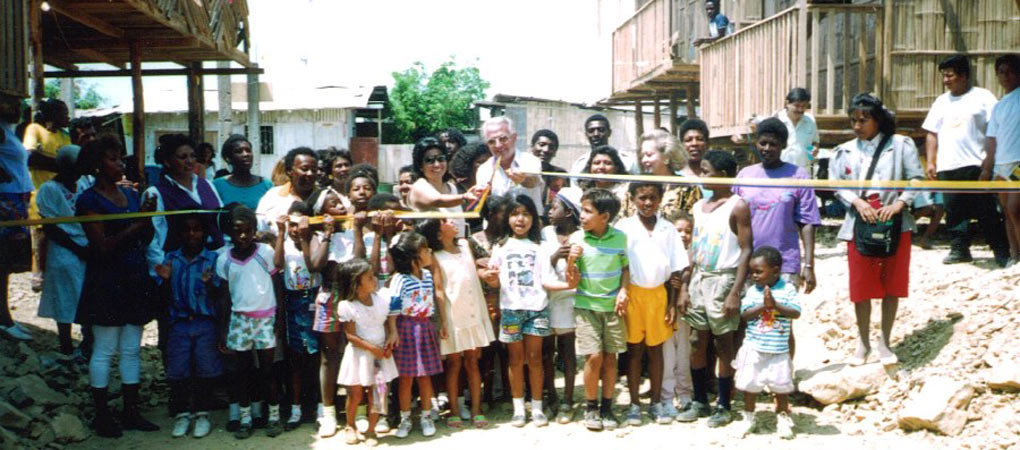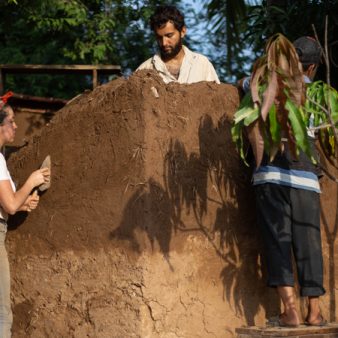This project was originally established by a local priest 25 years ago and has provided 100,000 homes to date (2004) and continues to extend its activities. The dwellings are made of bamboo prefabricated panels which are produced in a small production plant, providing employment for over 50 local people. The bamboo is grown in sustainable plantations. Houses are simple and easy to construct and with simple guidance families can build their own homes in a day. The dwellings cost only one seventh of the cheapest government house and affordable credit is provided to enable families to buy their own homes. Donor aid is used to extend the capacity of the manufacturing plant and to meet the needs of those who have no other source of income.
Ecuador lies on the western coast of South America and has a total population of 11 million. Guayaquil is the largest city and the economic capital of the country and is located in the southern part of the country on the Pacific coast. Its port and large industrial base attracted many migrants to the city and it is estimated that 9 per cent of the population are homeless.
The Viviendas del Hogar de Cristo (CHD) project was started in 1971 by Jesuit priests in response to the dreadful housing conditions of the poor people. Brother Francisco Garcia (Uncle Paco) established Viviendas del Hogar de Cristo (Christ’s Home Dwellings) building the first houses of wood and bamboo himself. The work has since gone from strength to strength. Today the NGO has its own manufacturing plant to produce the bamboo panels needed and this is a modern and dynamic enterprise. It is one of the most productive enterprises in Ecuador but is not profit-making. Its over-rising principle is that ‘no family who comes to us and really needs a dwelling will go empty-handed.’
CHD has helped 16,000 families provide themselves with decent homes over the last 25 years. This is done through the production of prefabricated bamboo panels and the beneficiaries are shown how to assemble the panels to form a simple house. The houses are similar to those that the people themselves put up when they invade land but they are cheaper, longer lasting and can be purchased over 24 months using hire purchase. This dwelling is seen only as a first step though. The project recognises that a house made of wood and bamboo today is better than a cement house in five years time but urges families to see their bamboo house as the first step in acquiring a solid, long-lasting and decent home.
The house design is based on one using mangle wood and bamboo that has been used locally for centuries. It performs well in the humid equatorial climate. Many of the dwellings are raised above the ground level due to the problems of flooding. The foundations are made of piles of mangle wood driven into the ground. The walls are made of wooden panels covered with bamboo, the floor is made of wooden boards and the roof is either made of zinc or corrugated iron. Easy instructions are provided for the assembly of a CHD home and it is possible for a family to build their home in a single day. The residents find the dwelling easy to maintain and enlarge when needed. Over the years amendments have been made to the design to minimise the amount of material used and to keep the costs down. There is no water supply or sanitation included and the owners come together to ask the municipality to supply such services.
The beneficiaries are primarily outcast social groups living in slums or on the streets, often they are deserted mothers, people who have been evicted from their rented homes and young couples without resources. Potential beneficiaries apply for housing and provide information about their income and the family position. 90 per cent of households receiving a home are women headed households and the average family size is seven. Priority is given to those applicants who are genuinely the poorest of the poor. 80,000 people have benefited to date and a further 1,716 homes are expected to be produced in 1996.
The beneficiaries purchase their homes, repaying the cost in 24 monthly instalments which are each equivalent to 14 – 24 per cent of the minimum monthly wage. Title to the dwelling rests with the mother and her children in order to ensure the future stability of the family. CHD offers its houses at a price seven times lower than the social homes of the government. The smallest CHD house is 21 m2 and costs $522, the largest is 44 m2 and this costs $883. Prices are kept in line with inflation. The cheapest government house is $3,252 and the most expensive $7,317. For those families who have no means of paying at all financial help is given. The repayment of loans is high, only 2 per cent of people who can pay choose not to do so. The usual reasons for not paying are a death of one of the income earners, unemployment, father leaving and other domestic disasters. In these cases the costs are met from a social fund operated by the project. The money received in instalments is reinvested in the building of new homes. New external aid is used to increase the volume of production.
The financing of the project is partly self-financing and partly dependent on overseas aid. The balance will vary from year to year but in 1994 virtually 50 per cent of the expenditure of $900,000 came from repayments and deposits from the beneficiaries. The remainder came from German overseas aid funds. Increases in external funding enable more units to be produced per day in the manufacturing plant.
The manufacturing plant covers 7,000 m2 and has 52 full-time employees. The maximum capacity of the plant is 12 homes a day.
Since 1989 CHD has developed the experimental research project known as Nazareth’s Home in order to try and improve the homes of wood and bamboo that CHD had been manufacturing for 17 years. 285 concrete block dwellings have been developed in four phases and the project seeks to develop a more complete solution to the human settlements problem – looking at urban planning, infrastructure and services, sociological aspects of the training and promotion of community. The project is aimed at strengthening local communities through a democratic system of electing its representatives, managing its own infrastructure provision, organising community services such as day nurseries, outpatients’ clinics and libraries and helping in the running of the construction programme. The final cost of a 38 m2 house is $2,250 payable over ten years. This represents a cost of $18.75 a month which is all that the poorest families can afford. The houses are built of concrete block using self-help and water, electricity and drainage services are provided in the project. The costs of construction are kept down with the use of self-help but are still substantially subsidised by CHD. The Municipality of Guayaquil has asked CHD to develop another such model plan for 54 social homes.
CHD shows how the poorest of the poor can be helped to help themselves. The dwellings provided are simple but provide stability and security for the destitute families of Guayaquil who have nothing. Families extend and improve their dwellings as their needs and/or resources increase. Since the bamboo for the construction is grown in sustainable plantations, the work of CHD serves to ensure environmental as well as social sustainability and provides an example capable of replication both in Latin America and beyond.
Partnership
NGO, local community



